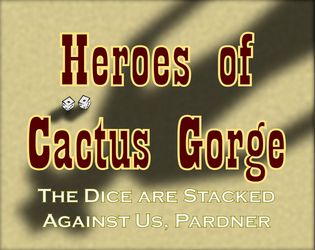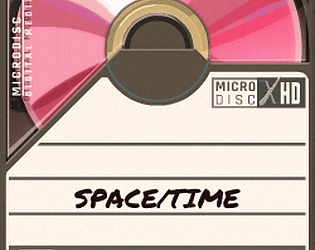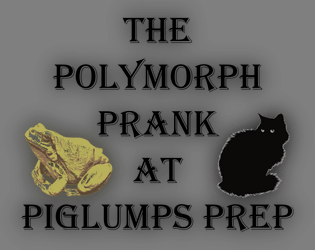This reads like a fully-fleshed out RPG experience, and it fits on one side of the paper. Now I'm jealous.
Jabberwockist
Creator of
Recent community posts
The Resilience Points mechanic is a very cool twist on roll-under systems. I've seen a couple diceless systems use something similar, but never pitted against an adjustable die with which you're attempting to make the roll.
Speaking of adjusting the die, that's my one big complaint: I wish the rules were clearer about exactly how the GM is supposed to adjust the die. One step up or down per trait that matches? One step max if any trait matches? Just go by feel in each situation? It might be worth a half-inch of text to explain.
Well done!
The concept is creative and executed well.
Your tutorial is crystal clear, thanks in large part to the pictures.
The goal is well defined, the mechanics are intuitive, and the game state is easy to read.
The game is difficult in a way that still feels fair. Whenever I miss and hit a cop, I feel like I should have timed things better.
Playing this after Robot Fighting Mechanic, I'm impressed by how well you've put into practice what you learned from previous jams.
I found this game too frustrating to enjoy. Here's why.
- Even after I read the instructions all the way through, it wasn't until the fourth play and reading the instructions a second time that I understood how to play.
- It wasn't until the second play through that I figured out how to grab parts.
- Even once I knew how to play, the repair round timer seemed arbitrary. It wasn't uncommon for my robot to need five or six parts in a single round, even though I barely had time to deliver two, even when I was already holding one.
- There seem to be invisible barriers everywhere. I have to be standing six feet upstage of the conveyor belt to walk behind it, and debris seems to have magical invisible boxes extending in unpredictable directions. Speaking of which, trying to clean up debris first requires me to play hide and seek with the particular pixel I have to walk into in order to get the SPACE prompt.
It seems like most of what didn't work for me was just a failure to communicate. Here's what you can do to help, if you're interested.
- Make a tutorial level. As a suggested outline: Have the robot request one part, stop time and explain to the player that they need to go to the shelf, then wait for the boxes and drop it in. Let them do that without a clock. Then have a piece of debris fly off. Once again, stop time and explain to the player how to clean it up. Don't let the game progress until they succeed. Then have the robot need two items at once. After that (untimed) repair round, turn the player loose.
- Think about where your player's focus is. When I tried to grab parts from the shelves, I didn't realize that I had succeeded and kept trying. That's because the only indication that I've grabbed a part is on the other side of the screen, and it's not readily apparent that that's my inventory, and not, say, a reminder of which part is needed. Have the part appear at the shelf, and have the character carry it. If you don't want to animate that, have the part appear at the shelf and then fly up into your inventory.
- Think about game language. In most games, an empty box or shelf with a sign above it showing an item means "When you find this item, you should place it here." I spent the first play through trying to grab items from the boxes so that I could bring them to the shelves.
- Try to match collision boxes to the visuals. When using a 3/4 overhead perspective, I've found putting the bounding box where I imagine each element touches the floor to be a helpful method.
"Okay, the walking is a little stiff and unresponsive. So far so boring."
"Oh, a step. I guess I have to jump over it."
Watches mummy and platform gently part ways with the delivery people in midair as if it were Aladdin on his flying carpet.
Realizes suddenly what the game is.
"Oh no." Splat.
"Okay, I need to get my brother to play this."
I'm glad I got to play this game. It was charming in a Studio Ghibli kind of way -- a rare delight in the world of free print-and-play games.
Your mechanics do a nice job of dangling the player over the precipice of defeat before yanking them back with what feels like a clutch play. Your rules are simple and effective, with enough wiggle room for players to develop their own strategy.
The best part, though, was undoubtedly the campaign. Nine of the ten opponents were well thought out and interesting in a Slay the Spire kind of way. The arc of your story, the description of the enemies, and the way they matched the mechanics were excellent.
A few things I would take a look at.
- Spelling and grammar! Proofread your work, and then have someone else proofread it, too. You'd be amazed how easily the wrong word can pull the reader out of a story.
- The Flea Soldiers. The story and the idea is incredibly cute. Actually fighting them was an exercise in frustration. It's not that they were difficult -- it was that missing completely on five out of six rolls makes the player feel like they are incapable of making progress. Or at least makes me feel that way, and I assume others do, too. It also risks turning the best part of the game into busywork, as the player will generally have almost nothing to heal. Try something for me: fight the Flea Soldiers as you have them now, and then try them with 25 health, and with the following rule in place of only hitting on doubles: "Little Warrior's damage is reduced to 1 per die, unless he rolls doubles". See which one feels better. It might just be me, but being able to make at least a little progress each turn feels better than making no progress at all most turns.
- I might see what other effects I could tie to certain poker hands, or shuffle around the ones that are already there. For example, I found straights to be surprisingly hard to get (much harder than flushes) and relatively lackluster compared to other options. Again, this might just be me and the way I play.
- Finally, I would name the spells and give them some flavor text. You obviously have a talent for game narrative, and it was odd that you didn't apply this strength to your game's mechanical centerpiece. It's cool that a flush gives me three turns without damage, but you haven't shown me why it works that way in the narrative. Am I creating floating shields? Mirror images of Little Warrior that draw fire? Fireflies that dazzle the opponent so they can't see to attack?
I give this a 9 out of 10. It has...
- A great take on the theme.
- Simple, easy to understand game play.
- Effective, easy-to-read sound and graphics.
- Some great moments (the night getting pitch black at midnight, the first time you see a red ghost flying at you).
- Good pacing. The tension slowly increases, then lets up, and then you get to relax for a bit and buy things. I played through to end and it never felt old.
- Elegance! It feels like everything present serves the game. Well done keeping focused!
Two things I might change:
- Right now it feels like I'm upgrading the flower instead of taking care of it. The two game modes are thematically intertwined, but I wish the two game modes felt more mechanically intertwined as well. The bug spray mini-game was a good attempt, put felt lackluster compared to everything else you did. Look for ways to make it feel like I'm actively taking care of the flower.
- I have enough friends who are colorblind to wonder if they'd be able to tell the different ghosts apart. Maybe change their silhouettes as well?
Hello nsceusa! I made a print-and-play cooperative board game: The Polymorph Prank at Piglumps Prep, for 1 to 4 players. I'm quite proud of it, but be warned: if you want to play it, you'll need to cut out 90 cards.
Thank you for starting this thread. If I have time, I'd like to compile a list of links to print-and-play projects I come across while exploring.
Edit: Forgot that I should include a link to my game. https://itch.io/jam/extra-credits-game-jam-6/rate/739409




